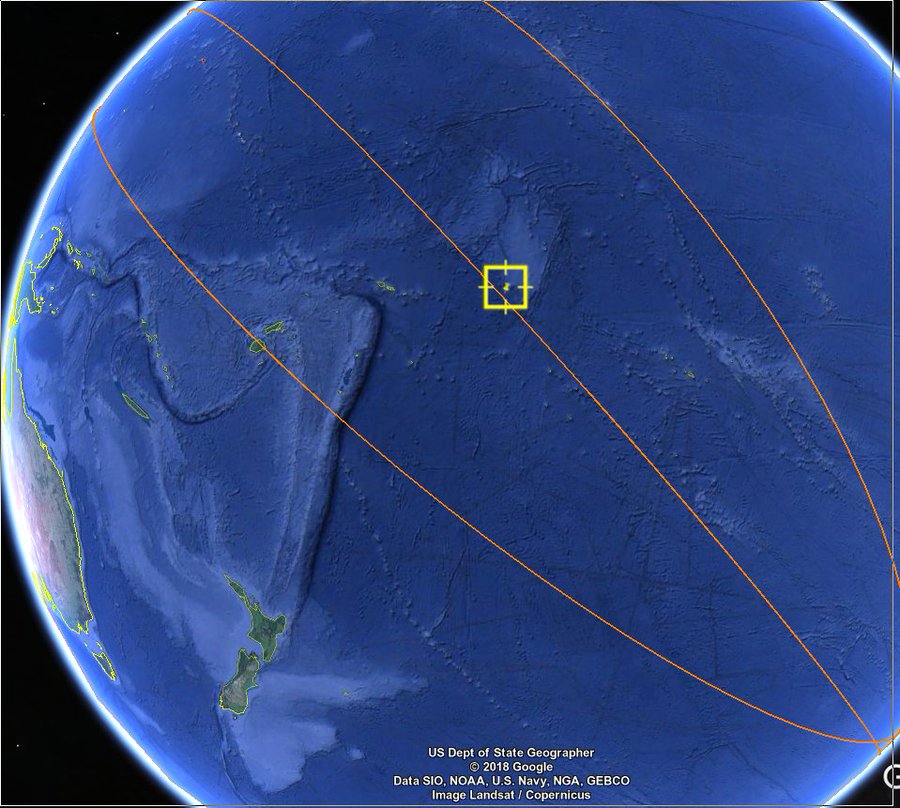China’s out-of-control space station — Tiangong-1 — has at last plunged through Earth’s atmosphere and landed somewhere over the southern Pacific Ocean. The spiraling spacecraft made its descent at around 8:16PM ET on April 1st, according to US Strategic Command, which was able to confirm the exact point of reentry along with organizations in eight other countries. The vehicle’s fall puts an end to the space station’s seven years in orbit, and it managed not to hit any populated areas on the way down.
It was hard to know exactly where Tiangong-1 was going to make its final descent, which is the case for most falling space debris. Sunday afternoon, trackers were able to narrow down the time of the vehicle’s reentry to a three- to four-hour window, but pinpointing the place of the fall was always going to be variable. The space station was orbiting in lower Earth orbit at about 17,000 miles per hour. So if an estimate was off by an hour, the station would have been 17,000 miles away in a different spot.
Tiangong-1’s uneventful demise caps off years of anxiety about where this spacecraft was going to come down. The space station was a particularly heavy and dense vehicle, and experts predicted that large pieces of it would probably survive the fall through Earth’s atmosphere. However, the odds were always good that it wouldn’t hit anyone. The Earth is mostly covered in ocean and most of our planet’s land is unpopulated, making it incredibly unlikely that any people were in any danger. In fact, a person’s lifetime risk of getting hit by space debris is one in 1 trillion, according to the Aerospace Corporation, a nonprofit that provides research and guidance on space missions.
Launched in 2011, Tiangong-1 — or the “Heavenly Place” — was China’s first human space station. Two sets of crews visited the vehicle during its time in orbit, one of which included China’s first female astronaut. But the station was really only meant to last for a couple of years in space. The original plan was to fire up Tiangong-1’s engines and propel the spacecraft out of orbit, so that it safely fell into open ocean. Then the vehicle’s successor, Tiangong-2, would take over as China’s primary astronaut habitat.
/cdn.vox-cdn.com/uploads/chorus_asset/file/10550445/TG1_on_orbit_002.jpg)
But China wound up extending Tiangong-1’s time in orbit, perhaps as a stop-gap measure in case Tiangong-2 didn’t make it up in time. Then in 2016, the country’s space agency informed the United Nations that it had lost control of Tiangong-1. That meant China could no longer send commands to the spacecraft while it was in orbit.
And what goes into lower Earth orbit pretty much always comes down. A very thin atmosphere extends out into this region of space, so small air particles are constantly bumping into satellites in lower Earth orbit, nudging them off their path. Unless these low orbiting vehicles have thrusters to periodically raise their orbits, they’ll eventually come down and burn up after entering the bulk of our planet’s atmosphere.
What made everyone so anxious about Tiangong-1 was its weight. When it launched, it weighed 18,740 pounds (8,500 kilograms), making it pretty hefty. Plus, it’s dense, too, so it wasn’t going to burn up completely in the atmosphere. Typically, most countries and commercial companies have plans to safely dispose of spacecraft of this size when they’ve reached the end of their lifetimes.
However, satellites and rocket pieces do fall to Earth all the time uncontrolled. In fact, this isn’t even the first time something this large has reentered the atmosphere without help from controllers on the ground. The upper stage of a Russian Zenit rocket fell to Earth in January of this year, and it weighed nearly the same as Tiangong-1. Plus in the past, even heftier items dove to the ground uncontrolled. In 2011, a 30,000-pound Russian spacecraft called Phobos-Grunt failed on its way to Mars and fell back to Earth. And in 1979, NASA’s old space station Sky Lab also plunged to Earth without aid. That one weighed nearly 160,000 pounds, too.
So there is definitely precedence for Tiangong-1’s spiraled descent, and there are likely to be similar reentries in the years ahead. It’s just the risk of launching big things to space.

